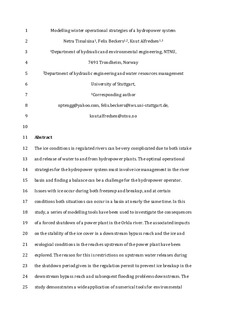| dc.contributor.author | Timalsina, Netra Prasad | |
| dc.contributor.author | Beckers, Felix | |
| dc.contributor.author | Alfredsen, Knut | |
| dc.date.accessioned | 2018-01-02T10:21:53Z | |
| dc.date.available | 2018-01-02T10:21:53Z | |
| dc.date.created | 2015-11-12T21:21:22Z | |
| dc.date.issued | 2016 | |
| dc.identifier.citation | Cold Regions Science and Technology. 2016, 122 1-9. | nb_NO |
| dc.identifier.issn | 0165-232X | |
| dc.identifier.uri | http://hdl.handle.net/11250/2473930 | |
| dc.description.abstract | The ice conditions in regulated rivers can be very complicated due to both intake and release of water to and from hydropower plants. The optimal operational strategies for the hydropower system must involve ice management in the river basin and finding a balance can be a challenge for the hydropower operator. Issues with ice occur during both freezeup and breakup, and at certain conditions both situations can occur in a basin at nearly the same time. In this study, a series of modelling tools have been used to investigate the consequences of a forced shutdown of a power plant in the Orkla River. The associated impacts on the stability of the ice cover in a downstream bypass reach and the ice and ecological conditions in the reaches upstream of the power plant have been explored. The reason for this is that there are restrictions on upstream water releases during the shutdown period given in the regulation permit to prevent ice breakup in the downstream bypass reach and subsequent flooding problems downstream. The study demonstrates a wide application of numerical tools for environmental impact assessment, providing knowledge for better decision-making and for optimal operational strategies for hydropower systems during winter.
In summary, the analysis shows that a shutdown period shorter than the travel time of water from the upstream hydropower plants to the bypassed reach does not guarantee a reduction of the ice problems in the bypass reach. Since the intake pond is too small to store already released water from the upstream power plants, spill and ice breakup will occur. It is rather found that a shutdown of the upstream power plants can induce environmental problems due to the rapid dewatering of the river, and an ice breakup during the restart of the upstream power plants. | nb_NO |
| dc.language.iso | eng | nb_NO |
| dc.publisher | Elsevier | nb_NO |
| dc.rights | Attribution-NonCommercial-NoDerivatives 4.0 Internasjonal | * |
| dc.rights.uri | http://creativecommons.org/licenses/by-nc-nd/4.0/deed.no | * |
| dc.title | Modelling winter operational strategies of a hydropower system | nb_NO |
| dc.type | Journal article | nb_NO |
| dc.type | Peer reviewed | nb_NO |
| dc.description.version | acceptedVersion | nb_NO |
| dc.source.pagenumber | 1-9 | nb_NO |
| dc.source.volume | 122 | nb_NO |
| dc.source.journal | Cold Regions Science and Technology | nb_NO |
| dc.identifier.doi | 10.1016/j.coldregions.2015.11.002 | |
| dc.identifier.cristin | 1288675 | |
| dc.relation.project | Norges forskningsråd: 193818 | nb_NO |
| dc.description.localcode | © 2015. This is the authors’ accepted and refereed manuscript to the article. This manuscript version is made available under the CC-BY-NC-ND 4.0 license http://creativecommons.org/licenses/by-nc-nd/4.0/ | nb_NO |
| cristin.unitcode | 194,64,91,0 | |
| cristin.unitname | Institutt for bygg- og miljøteknikk | |
| cristin.ispublished | true | |
| cristin.fulltext | postprint | |
| cristin.qualitycode | 2 | |

